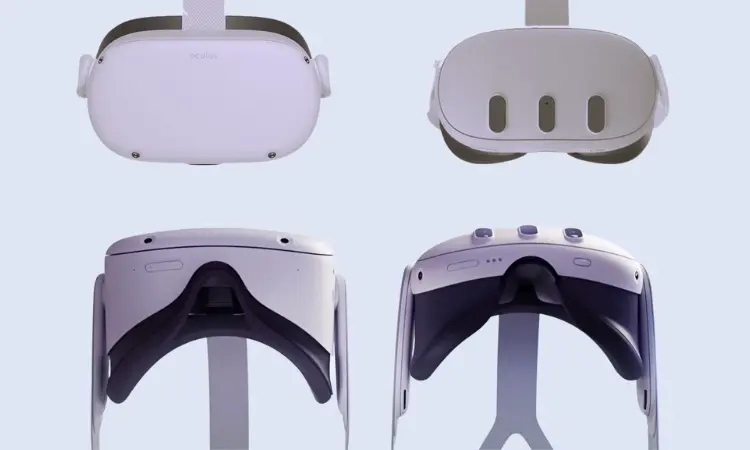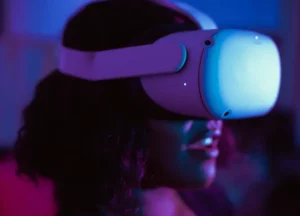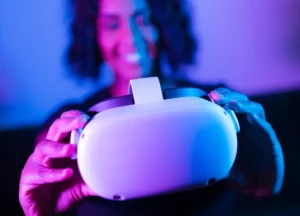
The Million-dollar question on Meta Quest Vs Meta Quest 3, “Which is better, Meta Quest 2 or 3?” is already vibing before Quest 3 hits the market this fall. Now that the Meta Quest 3 has been confirmed, many players may be wondering whether or not they should wait for its release this autumn and whether or not Quest 2 is better.
Even if Meta hasn’t revealed everything about Quest 3, we have enough information to let you make a decision, especially considering the abundance of reliable leaks we have to fill in the blanks. With Apple anticipated to unveil its mixed-reality headset at a price point of approximately $3,500 USD, Meta’s inexpensive VR headset line could be in for even more attention this year. In this context, a $500 headset will seem like a steal.
Let us dive into their detailed comparison:
| Meta Quest 3 | Meta Quest 2 | |
| Price | $499 (128GB) | $399 (128GB), $429 (256GB) |
| Release date | 2023 (expected) | 2020 |
| Chipset | TBA next-gen Qualcomm Snapdragon | XR2 |
| Display resolution | TBA | 1832 x 1920 per eye |
| Storage | 128GB, TBA larger size | 128GB, 256GB |
| RAM | TBA | 6GB |
| Battery life | TBA | 2-3 hours (rated) |
| Size | TBA (40% slimmer than Quest 2) | 7.5 x 4 x 5.2 inches |
| Weight | TBA | 1.1 pounds |
| Mixed reality passthrough | Full-color passthrough | Limited black and white passthrough |
Comparison Based On Price and Availability
One of the greatest arguments in favour of the Meta Quest 2 is its low price. The 128GB version presently costs $399, while the 256GB version costs $429. However, Meta promised a significant price reduction for its current-generation VR headset in the blog post launching the Meta Quest 3.
On 6/4, the Quest 2 128GB will cost $299.99 and the 256GB will cost $349.99. That’s $200 less than the 128GB version of the Meta Quest 3, which retails for $499. Meta has hinted at the release of a Quest 3 with increased memory, although specifics on this newer model have not been disclosed as of this writing.
The Design
Despite being “reimagined and redesigned,” the Meta Quest 3’s headgear design is surprisingly similar to that of the Quest 2. However, there are significant distinctions between the two headsets upon closer inspection.
In particular, Meta claims that the Quest 3 is 40% thinner than the Quest 2. When comparing the Quest 3 to the previous generation, the latter is substantially more compact. Pancake optics play a role in this since they permit greater resolution lenses to be packed into constrained areas by stacking optical film.
The Quest 3 has a sleek new look and is equipped with cameras in the visor. The system consists of a depth camera and two 4-megapixel RGB colour cameras. A more accurate rendering of the room you’re using the Quest 3 in and full-colour video passthrough are both made possible by this.
These aren’t the only alterations; there are a couple more. The Quest 3’s wheel for adjusting the lenses’ IPD should make it unnecessary to constantly remove and replace lenses. The Y-shaped top strap is an improvement over the regular straight back and should result in a more secure and comfortable fit.
Whether or not repositioning the speakers such that sound is projected downward rather than upward is an enhancement is debated. The speakers in Quest 2 were already top-notch, so we’re crossing our fingers that this is just an incremental upgrade.

Display Quality
While the Quest 2’s screen is adequate, newer devices offer superior visuals. The PSVR 2’s dual 4K OLED screens of 2,000 by 2,040 pixels make up for the lower resolution of 1832 by 1920 per eye. However, it is consistent with the Meta Quest Pro, which also has a resolution of 1832 x 1920 for each eye.
Details about how Meta Quest 3 will look are currently scant, unfortunately. That “Quest 3 combines our highest resolution display yet and pancake optics to ensure content looks better than ever” is the only hint Meta has given us so far. Even while we don’t know the exact pixel count, we know that it will be higher than the Quest 2 and Quest Pro.
Comparison Between their drivers
Unlike the Quest 2 version, the Quest 3 Touch Plus controllers don’t feature a unique tracking ring. Others are concerned that the new controllers may still have tracking issues, despite taking inspiration from the Touch Pro controllers for the Quest Pro. On the other hand, the Quest 3 appears to require no additional controls thanks to its native hand tracking.
We can assume that, like the Quest 2 controller before it, disposable batteries will be required for the Quest 3 controller. There was no mention of rechargeable controllers in the statement, although it could be because details are being withheld until the September Meta Connect conference.
What to Expect From Their Performing Abilities?
When it comes to performance, Meta hasn’t provided us with nearly as much information as they have about display resolution. However, their previous statements have been rather conclusive.
When Meta first announced the Quest 3, they hailed it as “our most powerful headset yet.” The headset will have a next-generation Qualcomm Snapdragon SoC processor, the identity of which has not been revealed, but which, according to Meta, “delivers more than twice the graphical performance as the previous generation Snapdragon GPU in Quest 2.” Meta promises additional information before the end of the year.
This may be a different chipset altogether, perhaps a revised version of the Qualcomm Snapdragon XR2+ seen in the Meta Quest Pro. We only know that it will be an upgrade from the Quest 2’s Qualcomm Snapdragon XR2.
What About Battery life?
Depending on the task at hand, the Meta Quest 2’s battery life is currently estimated to last between two and three hours. I think I used around half my battery watching Cocaine Bear in VR for 90 minutes, but VR gaming will need more power.
Meta has not yet provided any information about the Quest 3’s battery life. We haven’t even heard a whisper or a leak. But if the Quest 3 can’t last for at least three hours, it would be a major letdown.
Based on Game Compatibility
Good news for anyone contemplating purchasing a Quest 3: it will be compatible with all of the existing titles for the Quest 2. That includes the new games that were announced at the Meta Quest Gaming Showcase 2023, which means you may play all 500+ Quest 2 games right away.
There has been no public announcement of any Quest 3 features that are incompatible with Quest 2, but we expect this to change shortly. Developers typically take advantage of the Quest 3’s enhancements, like its speedier processor and more mixed reality capabilities, in due time.
While it’s likely that games will be released for both systems for the time being. Since the Quest 2 is the key gateway device for the platform, Meta has no plans to phase it out anytime soon. The upcoming Quest 2 chipset software update will increase CPU performance by up to 26% and GPU speed by up to 19%. This patch will allow the Quest 2’s frame rate to be stabilized in light of the greater resolution.
If you’re just getting started in the gaming world and looking for some suggestions, check out our recommended Meta Quest 2 games.
Several Other Factors to Consider
The capability to handle mixed reality is the key differentiator between the two headsets. The Quest 2 is, to put it plainly, a virtual reality (VR) headset. The Quest 2 provides a black-and-white video passthrough, but its main purpose is to pinpoint your location.
However, it appears that the Quest 3 will make use of the video portal’s full-colour capabilities. The Quest 3’s camera array and depth sensor work together to render an accurate image of your surroundings, and each camera has 10 times the resolution of the Quest 2’s monochrome cameras.
Meta has not yet shown off its whole vision for mixed reality on Quest 3, but it did give us a little glimpse in the introduction trailer. In one scene, a Quest 3 player is using the table in front of them to play the virtual reality game Demeo, rather than the virtual tabletop that comes with the game.
Which is better for you, Meta Quest 3 or Meta Quest 2?
The good news is that it seems the Quest 2 will remain in Meta’s lineup of virtual reality headsets. Getting a Quest 2 now isn’t a waste of money because of the upcoming price drop to $299 and the ongoing software updates that improve performance. Even while Meta plans to put it aside for Quest 3 eventually, that day is still quite a ways off.
The Meta Quest 3 seems to be the best option if you want to switch back and forth between the virtual and physical worlds without switching headsets. While its $499 price tag may seem steep at launch, the Quest 3 has the potential to become the greatest virtual reality headset for the vast majority of users if developers begin creating games and apps that take advantage of its mixed reality capabilities.
Generally speaking, the more recent the technology, the better. There is no avoiding it. As more mixed-reality experiences and features are added to Quest 3, the gap between the Meta Quest 3 and Quest 2 will expand even further.
The Quest 3 is approximately three times as quick as the Quest 2, and its lenses are thinner and clearer. It is also more compact, has better controllers, and better hand tracking. Meta has already confirmed what everyone already knows: Quest 3 will include exclusive games down the line, even if they won’t be available at launch.
The Quest 2 is still a great option at $299 if you’re just getting started with virtual reality. Depending on your requirements and available funds, you can choose between the Quest 2 128 and 256 GB.
The Quest 3 will launch this autumn for $499 and provide users with extraordinary, one-of-a-kind experiences that can’t be had anyplace else.
Final Words
We have discussed every area which you can consider before buying one of these two brilliant VR headsets. We have also discussed that if you have the budget and already own a Quest 2, you can surely go for Quest 3 as it is said,” The Newer, The Better.” Hope this featuring “Meta Quest Vs Meta Quest 3” helps you with precise decision-making before diving into the simulated world of VR and its advancement.






